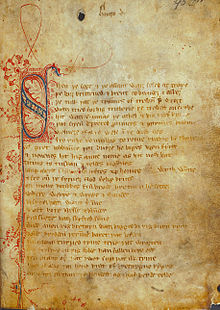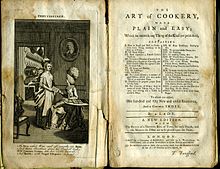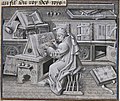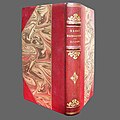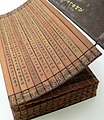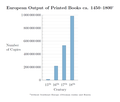Portal:Books
The Books Portal
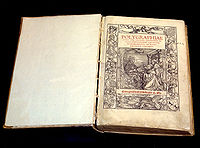
A book is a medium for recording information in the form of writing or images. Books are typically composed of many pages, bound together and protected by a cover. Modern bound books were preceded by many other written mediums, such as the codex and the scroll. The book publishing process is the series of steps involved in their creation and dissemination.
As a conceptual object, a book typically refers to a written work of substantial length, which may be distributed either physically or in digital forms like ebooks. These works are broadly classified into fiction (containing imaginary content) and non-fiction (containing content representing truths). Many smaller categories exist within these, such as children's literature meant to match the reading level and interests of children, or reference works that gather collections of non-fiction. Books are traded at both regular stores and specialized bookstores, and people can borrow them from libraries. The reception of books has led to a number of social consequences, including censorship.
A physical book does not need to contain written works: for example, it may contain only drawings, engravings, photographs, puzzles, or removable content like paper dolls. Physical books may be left empty to be used for writing or drawing, such as account books, appointment books, autograph books, notebooks, diaries and sketchbooks.
The contemporary book industry has seen several major changes due to new technologies. In some markets, the sale of printed books has decreased due to the increased use of eBooks. However, printed books still largely outsell eBooks, and many people have a preference for print. The 21st century has also seen a rapid rise in the popularity of audiobooks, which are recordings of books being read aloud. Additionally, awareness of the needs of people who can't access print media due to limitations like visual impairment has led to a rise in formats designed for greater accessibility, such as braille printing or formats supporting text-to-voice. Google Books estimated that as of 2010, approximately 130,000,000 unique books had been published. (Full article...)
Featured articles -
-
Louis Riel is a historical biography in comics by Canadian cartoonist Chester Brown, published as a book in 2003 after serialization in 1999–2003. The story deals with Métis rebel leader Louis Riel's antagonistic relationship with the newly established Canadian government. It begins shortly before the 1869 Red River Rebellion, and ends with Riel's 1885 hanging for high treason. The book explores Riel's possible schizophrenia—he believed God had named him Prophet of the New World, destined to lead the Métis people to freedom.
The work is noted for its emotional disengagement, its intentionally flat dialogue, and a minimalist drawing style inspired by that of Harold Gray's comic strip Little Orphan Annie. Unusual for comics of the time, it includes a full scholarly apparatus: a foreword, index, bibliography, and end notes. The lengthy, hand-lettered appendix provides insight into Brown's creative process and biases and highlights where he changed historical facts to create a more engaging story, such as incorporating a conspiracy theory not widely accepted by historians. Brown became interested in the issue of property rights while researching the book, which led to a public change in his politics from anarchism to libertarianism. (Full article...) -

Title page from the first edition of Locke's Some Thoughts Concerning Education (1693)
Some Thoughts Concerning Education is a 1693 treatise on the education of gentlemen written by the English philosopher John Locke. For over a century, it was the most important philosophical work on education in England. It was translated into almost all of the major written European languages during the eighteenth century, and nearly every European writer on education after Locke, including Jean-Jacques Rousseau, acknowledged its influence.
In his Essay Concerning Human Understanding (1690), Locke outlined a new theory of mind, contending that the mind is originally a tabula rasa or "blank slate"; that is, it did not contain any innate ideas at birth. Some Thoughts Concerning Education explains how to educate that mind using three distinct methods: the development of a healthy body; the formation of a virtuous character; and the choice of an appropriate academic curriculum. (Full article...) -
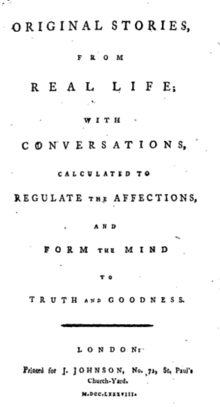
Title page from the first edition of Original Stories (1788)
Original Stories from Real Life; with Conversations Calculated to Regulate the Affections, and Form the Mind to Truth and Goodness is the only complete work of children's literature by the 18th-century English feminist author Mary Wollstonecraft. Original Stories begins with a frame story that sketches out the education of two young girls by their maternal teacher Mrs. Mason, followed by a series of didactic tales. The book was first published by Joseph Johnson in 1788; a second, illustrated edition, with engravings by William Blake, was released in 1791 and remained in print for around a quarter of a century.
In Original Stories, Wollstonecraft employed the then-burgeoning genre of children's literature to promote the education of women and an emerging middle-class ideology. She argued that women would be able to become rational adults if they were educated properly as children, which was not a widely held belief in the 18th century, and contended that the nascent middle-class ethos was superior to the court culture represented by fairy tales and to the values of chance and luck found in chapbook stories for the poor. Wollstonecraft, in developing her own pedagogy, also responded to the works of the two most important educational theorists of the 18th century: John Locke and Jean-Jacques Rousseau. (Full article...) -
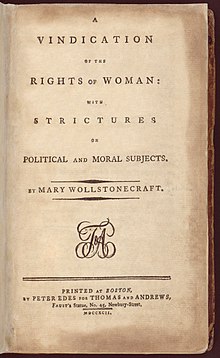
A Vindication of the Rights of Woman: with Strictures on Political and Moral Subjects (1792), written by British philosopher and women's rights advocate Mary Wollstonecraft (1759–1797), is one of the earliest works of feminist philosophy. In it, Wollstonecraft responds to those educational and political theorists of the eighteenth century who did not believe women should receive a rational education. She argues that women ought to have an education commensurate with their position in society, claiming that women are essential to the nation because they educate its children and because they could be "companions" to their husbands, rather than mere wives. Instead of viewing women as ornaments to society or property to be traded in marriage, Wollstonecraft maintains that they are human beings deserving of the same fundamental rights as men.
Wollstonecraft was prompted to write the Rights of Woman after reading Charles Maurice de Talleyrand-Périgord's 1791 report to the French National Assembly, which stated that women should only receive domestic education. From her reaction to this specific event, she launched a broad attack against double standards, indicting men for encouraging women to indulge in excessive emotion. Wollstonecraft hurried to complete the work in direct response to ongoing events; she intended to write a more thoughtful second volume but died before completing it. (Full article...) -

Beginning of the text
The St Cuthbert Gospel, also known as the Stonyhurst Gospel or the St Cuthbert Gospel of St John, is an early 8th-century pocket gospel book, written in Latin. Its finely decorated leather binding is the earliest known Western bookbinding to survive, and both the 94 vellum folios and the binding are in outstanding condition for a book of this age. With a page size of only 138 by 92 millimetres (5.4 in × 3.6 in), the St Cuthbert Gospel is one of the smallest surviving Anglo-Saxon manuscripts. The essentially undecorated text is the Gospel of John in Latin, written in a script that has been regarded as a model of elegant simplicity.
The book takes its name from Saint Cuthbert of Lindisfarne, North East England, in whose tomb it was placed, probably a few years after his death in 687. Although it was long regarded as Cuthbert's personal copy of the Gospel, to which there are early references, and so a relic of the saint, the book is now thought to date from shortly after Cuthbert's death. It was probably a gift from Monkwearmouth–Jarrow Abbey, where it was written, intended to be placed in St Cuthbert's coffin in the few decades after this was placed behind the altar at Lindisfarne in 698. It presumably remained in the coffin through its long travels after 875, forced by Viking invasions, ending at Durham Cathedral. The book was found inside the coffin and removed in 1104 when the burial was once again moved within the cathedral. It was kept there with other relics, and important visitors were able to wear the book in a leather bag around their necks. It is thought that after the Dissolution of the Monasteries in England by Henry VIII between 1536 and 1541, the book passed to collectors. It was eventually given to Stonyhurst College, the Jesuit school in Lancashire. (Full article...) -
Expedition to the Barrier Peaks is a 1980 adventure module for the Advanced Dungeons & Dragons role-playing game written by Gary Gygax. While Dungeons & Dragons (D&D) is typically a fantasy game, the adventure includes elements of science fiction, and thus belongs to the science fantasy genre. It takes place on a downed spaceship; the ship's crew has died of an unspecified disease, but functioning robots and strange creatures still inhabit the ship. The player characters fight monsters and robots, and gather the futuristic weapons and colored access cards that are necessary for advancing the story.
Expedition to the Barrier Peaks was first played at the Origins II convention in 1976, where it was used to introduce Dungeons & Dragons players to the science fiction game Metamorphosis Alpha. In 1980, TSR published the adventure, updated for first edition Advanced Dungeons & Dragons rules. The adventure was not updated for later rules systems, but a Wizards.com article did provide a conversion to Future Tech. It included a separate booklet of illustrations, in both color and black and white. The adventure is an old-time favorite of many Dungeons & Dragons fans, including Stephen Colbert. It was ranked the fifth-best Dungeons & Dragons adventure of all time by Dungeon magazine in 2004, and received positive reviews from White Dwarf and The Space Gamer magazines. The other adventures in the S series include S1 Tomb of Horrors, S2 White Plume Mountain, and S4 The Lost Caverns of Tsojcanth. (Full article...) -
Hemming's Cartulary is a manuscript cartulary, or collection of charters and other land records, collected by a monk named Hemming around the time of the Norman Conquest of England. The manuscript comprises two separate cartularies that were made at different times and later bound together; it is in the British Library as MS Cotton Tiberius A xiii. The first was composed at the end of the 10th or beginning of the 11th century. The second section was compiled by Hemming and was written around the end of the 11th or the beginning of the 12th century. The first section, traditionally titled the Liber Wigorniensis, is a collection of Anglo-Saxon charters and other land records, most of which are organized geographically. The second section, Hemming's Cartulary proper, combines charters and other land records with a narrative of deprivation of property owned by the church of Worcester.
The two works are bound together in one surviving manuscript, the earliest surviving cartulary from medieval England. A major theme is the losses suffered by Worcester at the hands of royal officials and local landowners. Included amongst the despoilers are kings such as Cnut and William the Conqueror, and nobles such as Eadric Streona and Urse d'Abetot. Also included are accounts of lawsuits waged by the Worcester monks in an effort to regain their lost lands. The two sections of the cartulary were first printed in 1723. The original manuscript was slightly damaged by fire in 1733, and required rebinding. (Full article...) -

Title page from the second volume of Lives of the Most Eminent Literary and Scientific Men of France (1838)
The Lives of the Most Eminent Literary and Scientific Men comprised ten volumes of Dionysius Lardner's 133-volume Cabinet Cyclopaedia (1829–1846). Aimed at the self-educating middle class, this encyclopedia was written during the 19th-century literary revolution in Britain that encouraged more people to read.
The Lives formed part of the Cabinet of Biography in the Cabinet Cyclopaedia. Within the set of ten, the three-volume Lives of the Most Eminent Literary and Scientific Men of Italy, Spain and Portugal (1835–37) and the two-volume Lives of the Most Eminent Literary and Scientific Men of France (1838–39) consist of biographies of important writers and thinkers of the 14th to 18th centuries. Most of them were written by the Romantic writer Mary Shelley. Shelley's biographies reveal her as a professional woman of letters, contracted to produce several volumes of works and paid well to do so. Her extensive knowledge of history and languages, her ability to tell a gripping biographical narrative, and her interest in the burgeoning field of feminist historiography are reflected in these works. (Full article...) -
Race Against Time: Searching for Hope in AIDS-Ravaged Africa is a non-fiction book written by Stephen Lewis for the Massey Lectures. Lewis wrote it in early to mid-2005 and House of Anansi Press released it as a corresponding lecture series began in October 2005. Each of the book's chapters were delivered as a different lecture in a different Canadian city, beginning in Vancouver on October 18 and ending in Toronto on October 28. The speeches were aired on CBC Radio One between November 7 and 11. The author and orator, Stephen Lewis, was at that time the United Nations Special Envoy for HIV/AIDS in Africa and former Canadian ambassador to the United Nations. Although he wrote the book and lectures in his role as a concerned Canadian citizen, his criticism of the United Nations (UN), international organizations, and other diplomats, including naming specific people, was called undiplomatic and led several reviewers to speculate whether he would be removed from his UN position.
In the book and the lectures, Lewis argues that significant changes are required to meet the Millennium Development Goals in Africa by their 2015 deadline. Lewis explains the historical context of Africa since the 1980s, citing a succession of disastrous economic policies by international financial institutions that contributed to, rather than reduced, poverty. He connects the structural adjustment loans, with conditions of limited public spending on health and education infrastructure, to the uncontrolled spread of AIDS and subsequent food shortages as the disease infected much of the working-age population. Lewis also addresses such issues as discrimination against women and primary education for children. To help alleviate problems, he ends with potential solutions which mainly require increased funding by G8 countries to levels beyond what they promise. (Full article...) -
The Halo Graphic Novel is a graphic novel anthology of the military science fiction video game series Halo, published by Marvel Comics in partnership with Bungie. The Halo Graphic Novel was the series' first entry into the sequential art medium, and features aspects of the Halo universe which until then had not been discussed or seen in any medium.
The majority of the book is divided into four short stories by different writers and artists from the computer game and comic industries. Each story focuses on different aspects of the Halo universe, revealing stories that are tangential to the main plot of the game. Apart from the stories, the book also contains an extensive art gallery compiled of contributions from Bungie, Marvel and independent sources. (Full article...) -
Fuck: Word Taboo and Protecting Our First Amendment Liberties is a nonfiction book by law professor Christopher M. Fairman about freedom of speech, the First Amendment to the United States Constitution, censorship, and use of the word fuck in society. The book was first published in 2009 by Sphinx as a follow-up on the author's article "Fuck", published in 2007 in the Cardozo Law Review. It cites studies from academics in social science, psychoanalysis, and linguistics. Fairman establishes that most current usages of the word have connotations distinct from its meaning of sexual intercourse. The book discusses the efforts of conservatives in the United States to censor the word from common parlance. The author says that legal precedent regarding its use is unclear because of contradictory court decisions. Fairman argues that once citizens allow the government to restrict the use of specific words, this will infringe upon freedom of thought.
The book received a mostly favorable reception from news sources and library trade publications. Library Journal described the book as a sincere analysis of the word and its history of censorship, Choice: Current Reviews for Academic Libraries called it stimulating, and the San Diego Law Review said it was thought-provoking. One reviewer said that the book, like the article, was a format for the author to repeatedly use "fuck" rather than analyze it from a rigorous perspective. After the book's release, Fairman was consulted by media sources including CNN and The New York Times, as well as the American Civil Liberties Union, on issues surrounding word taboo in society. (Full article...) -
The Liber Eliensis is a 12th-century English chronicle and history, written in Latin. Composed in three books, it was written at Ely Abbey on the island of Ely in the fenlands of eastern Cambridgeshire. Ely Abbey became the cathedral of a newly formed bishopric in 1109. Traditionally the author of the anonymous work has been given as Richard or Thomas, two monks at Ely, one of whom, Richard, has been identified with an official of the monastery, but some historians hold that neither Richard nor Thomas was the author.
The Liber covers the period from the founding of the abbey in 673 until the middle of the 12th century, building on earlier historical works. It incorporates documents and stories of saints' lives. The work typifies a type of local history produced during the latter part of the 12th century. Similar books were written at other English monasteries. The longest of the contemporary local histories, the Liber chronicles the devastation that the Anarchy caused during the reign of King Stephen. It also documents the career of Nigel, the Bishop of Ely from 1133 to 1169, and his disputes with King Stephen. Other themes include the miracles worked by the monastery's patron saint, Æthelthryth, and gifts of land to Ely. (Full article...) -
The Log from the Sea of Cortez is an English-language book written by American author John Steinbeck and published in 1951. It details a six-week (March 11 – April 20) marine specimen-collecting boat expedition he made in 1940 at various sites in the Gulf of California (also known as the Sea of Cortez), with his friend, the marine biologist Ed Ricketts. It is regarded as one of Steinbeck's most important works of non-fiction chiefly because of the involvement of Ricketts, who shaped Steinbeck's thinking and provided the prototype for many of the pivotal characters in his fiction, and the insights it gives into the philosophies of the two men.
The Log from the Sea of Cortez is the narrative portion of an earlier work, Sea of Cortez: A Leisurely Journal of Travel and Research, which was published by Steinbeck and Ricketts shortly after their return from the Gulf of California, and combined the journals of the collecting expedition, reworked by Steinbeck, with Ricketts' species catalogue. After Ricketts' death in 1948, Steinbeck dropped the species catalogue from the earlier work and republished it with a eulogy to his friend added as a foreword. (Full article...) -
Sir Gawain and the Green Knight is a late 14th-century chivalric romance in Middle English alliterative verse. The author is unknown; the title was given centuries later. It is one of the best-known Arthurian stories, with its plot combining two types of folk motifs: the beheading game, and the exchange of winnings. Written in stanzas of alliterative verse, each of which ends in a rhyming bob and wheel, it draws on Welsh, Irish, and English stories, as well as the French chivalric tradition. It is an important example of a chivalric romance, which typically involves a hero who goes on a quest which tests his prowess. It remains popular in modern English renderings from J. R. R. Tolkien, Simon Armitage, and others, as well as through film and stage adaptations.
The story describes how Sir Gawain, who was not yet a knight of King Arthur's Round Table, accepts a challenge from a mysterious "Green Knight" who dares any man to strike him with his axe if he will take a return blow in a year and a day. Gawain accepts and beheads him, at which point, the Green Knight stands, picks up his head, and reminds Gawain of the appointed time. In his struggles to keep his bargain, Gawain demonstrates chivalry and loyalty until his honour is called into question by a test involving the lord and the lady of the castle at which he is a guest. The poem survives in one manuscript, Cotton Nero A.x., which also includes three religious narrative poems: Pearl, Cleanness, and Patience. All four are written in a North West Midlands dialect of Middle English, and are thought to be by the same author, dubbed the "Pearl Poet" or "Gawain Poet". (Full article...) -
A Journey is a memoir by Tony Blair of his tenure as Prime Minister of the United Kingdom. Published in the UK on 1 September 2010, it covers events from when he became leader of the Labour Party in 1994 and transformed it into "New Labour", holding power for a party record three successive terms, to his resignation and replacement as prime minister by his Chancellor of the Exchequer, Gordon Brown. Blair donated his £4.6-million advance, and all subsequent royalties, to the British Armed Forces charity the Royal British Legion. It became the fastest-selling autobiography of all time at the bookstore chain Waterstones. Promotional events were marked by anti-war protests.
Two of the book's major topics are the strains in Blair's relationship with Brown after Blair allegedly reneged on the pair's 1994 agreement to step down as Prime Minister much earlier, and his controversial decision to participate in the 2003 invasion of Iraq. Blair discusses Labour's future following the 2010 general election, his relations with the Royal Family, and how he came to respect President of the United States George W. Bush. Reviews were mixed; some criticised Blair's writing style, but others called it candid. (Full article...)
Selected picture

Credit: Anne de Felbrigge
More Did you know (auto generated)

- ... that Bulkboeken ('bulk books') were cheap reprints of Dutch literary classics, published from 1971 to the late 1990s, and again from 2007?
- ... that the journalist Wendell Steavenson's book Circling the Square covers the events of the 2011–2013 Egyptian crisis, which were centered around Cairo's Tahrir Square?
- ... that circulation numbers for early comic books featuring Captain America remained close to a million copies per month, outstripping news magazines such as Time?
- ... that a miniature book written by a 13-year-old sold for over $1 million?
- ... that artist Isaac Sailmaker (painting shown) was referred to in contemporary journals and books as "the father of British sea painting"?
- ... that in his book The Creative Gene, Hideo Kojima revealed that he would sacrifice his position as a game designer to go to outer space?
Books topics
Related portals
-
Yakov and the Seven Thieves is a picture book written by American entertainer Madonna. It was released on June 21, 2004, by Callaway Arts & Entertainment in over 110 countries and 38 different languages, including a Braille edition. The book contains a moral tale and was inspired by a 300-year-old story by rabbi Baal Shem Tov, that Madonna had heard from her Kabbalah teacher. The premise was set in a small, 18th century town in Eastern Europe, and the story talks about how everyone has the ability to open the gates of heaven, however unworthy one is deemed to be.
The cover art and the images inside were painted by Russian illustrator Gennady Spirin who chose Baroque painting as inspiration for crafting the characters and the scenery. Like her previous endeavors, Madonna promoted the release by appearing on talk show and reading to children at a hospital in London. Critics gave mixed review of the book, with reviews being mostly negative about Madonna's writing but praised Spirin's illustrations. Three weeks after its release, Yakov and the Seven Thieves debuted at number seven on The New York Times Best Seller list in the category for Children's Picture books. (Full article...) -
Etymologiae (Latin for 'Etymologies'), also known as the Origines ('Origins'), usually abbreviated Orig., is an etymological encyclopedia compiled by the influential Christian bishop Isidore of Seville (c. 560–636) towards the end of his life. Isidore was encouraged to write the book by his friend Braulio, Bishop of Saragossa. Etymologiae summarized and organized a wealth of knowledge from hundreds of classical sources; three of its books are derived largely from Pliny the Elder's Natural History. Isidore acknowledges Pliny, but not his other principal sources, namely Cassiodorus, Servius, and Gaius Julius Solinus.
Etymologiae covers an encyclopedic range of topics. Etymology, the origins of words, is prominent, but the work also covers, among other things, grammar, rhetoric, mathematics, geometry, music, astronomy, medicine, law, the church and heretical sects, pagan philosophers, languages, cities, humans, animals, the physical world, geography, public buildings, roads, metals, rocks, agriculture, war, ships, clothes, food, and tools. (Full article...) -
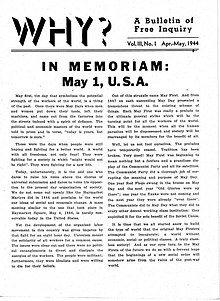
The May Pamphlet is a collection of six anarchist essays written and published by Paul Goodman in 1945. Goodman discusses the problems of living in a society that represses individual instinct through coercion. He suggests that individuals resist such conditions by reclaiming their natural instincts and initiative, and by "drawing the line", an ideological delineation beyond which an individual should refuse to conform or cooperate with social convention. While themes from The May Pamphlet—decentralization, peace, social psychology, youth liberation—would recur throughout his works, Goodman's later social criticism focused on practical applications rather than theoretical concerns.
The pamphlet was originally published piecemeal in small, New York anarchist journals and was first compiled as a set among literary essays in Art and Social Nature (1946). The essays were not well known before Goodman's 1960 book Growing Up Absurd led to a resurgence of interest in his oeuvre, including the pamphlet's republication in Drawing the Line (1962). The May Pamphlet was Goodman's principal contribution to anarchist theory and a primary influence on Colin Ward, who later dedicated Anarchy in Action to Goodman's memory. (Full article...) -
The New Dinosaurs: An Alternative Evolution is a 1988 speculative evolution book written by Scottish geologist and palaeontologist Dougal Dixon and illustrated by several illustrators including Amanda Barlow, Peter Barrett, John Butler, Jeane Colville, Anthony Duke, Andy Farmer, Lee Gibbons, Steve Holden, Philip Hood, Martin Knowelden, Sean Milne, Denys Ovenden and Joyce Tuhill. The book also features a foreword by Desmond Morris. The New Dinosaurs explores a hypothetical alternate Earth, complete with animals and ecosystems, where the Cretaceous-Paleogene extinction event never occurred, leaving non-avian dinosaurs and other Mesozoic animals an additional 65 million years to evolve and adapt over the course of the Cenozoic to the present day.
The New Dinosaurs is Dixon's second work on speculative evolution, following After Man (1981). Like After Man, The New Dinosaurs uses its own fictional setting and hypothetical wildlife to explain natural processes with fictitious examples, in this case the concept of zoogeography and biogeographic realms. It was followed by another speculative evolution work by Dixon in 1990, Man After Man. (Full article...) -
The Art of Cookery Made Plain and Easy is a cookbook by Hannah Glasse (1708–1770), first published in 1747. It was a bestseller for a century after its first publication, dominating the English-speaking market and making Glasse one of the most famous cookbook authors of her time. The book ran through at least 40 editions, many of which were copied without explicit author consent. It was published in Dublin from 1748, and in America from 1805.
Glasse said in her note "To the Reader" that she used plain language so that servants would be able to understand it. (Full article...) -
Lady Gaga: Queen of Pop is a biography of American singer Lady Gaga. It was written by Emily Herbert (pen name for the journalist Virginia Blackburn) and published in the United Kingdom by John Blake Publishing Ltd. The book was published by Overlook Press in the United States with the title Lady Gaga: Behind the Fame. Additional versions under the title Lady Gaga: Queen of Pop were published in 2010 by Wilkinson Publishing of Melbourne in Australia and by Gardners Books in the United Kingdom. The book discusses Gaga's early life when she was known as Stefani Joanne Angelina Germanotta from her birth in 1986, and chronicles her education at Convent of the Sacred Heart in New York, her early visits to nightclubs with her mother to perform at open-mic events, and her brief foray into the Tisch School of the Arts, leading up to her first experience of fame. Germanotta took the name "Lady Gaga" from the song "Radio Ga Ga" by the rock group Queen; she released her first album The Fame in 2008. Lady Gaga: Queen of Pop describes the musician's success in the industry, noting her business collaborations and appearance on the cover of Rolling Stone in 2009.
Lady Gaga: Queen of Pop received a mixed reception, and a reviewer for the Orlando Sentinel wrote a positive review. The Herald Sun criticized the book's style of commentary and its chronological organization style. A book critic for the St. Petersburg Times wrote positively about the photographs of Gaga in the book. The Phoenix New Times characterized its style as tending towards a positive tone, and compared it to a Wikipedia entry. A reviewer for the Minneapolis Star-Tribune criticized the book for being predictable. Ms. Magazine said that the book describes the musician's business acumen and motivation to maintain control of her image. A reviewer for the Las Vegas Review-Journal wrote that the book presented a detailed biography of the musician. (Full article...) -
A History of the Theories of Aether and Electricity is any of three books written by British mathematician Sir Edmund Taylor Whittaker FRS FRSE on the history of electromagnetic theory, covering the development of classical electromagnetism, optics, and aether theories. The book's first edition, subtitled from the Age of Descartes to the Close of the Nineteenth Century, was published in 1910 by Longmans, Green. The book covers the history of aether theories and the development of electromagnetic theory up to the 20th century. A second, extended and revised, edition consisting of two volumes was released in the early 1950s by Thomas Nelson, expanding the book's scope to include the first quarter of the 20th century. The first volume, subtitled The Classical Theories, was published in 1951 and served as a revised and updated edition to the first book. The second volume, subtitled The Modern Theories (1900–1926), was published two years later in 1953, extended this work covering the years 1900 to 1926. Notwithstanding a notorious controversy on Whittaker's views on the history of special relativity, covered in volume two of the second edition, the books are considered authoritative references on the history of electricity and magnetism as well as classics in the history of physics.
The original book was well-received, but it ran out of print by the early 1920s. Whittaker believed that a new edition should include the developments in physics that took part at the turn of the twentieth century and declined to have it reprinted. He wrote the second edition of the book after his retirement and published The Classical Theories in 1951, which also received critical acclaim. In the 1953 second volume, The Modern Theories (1900–1926), Whittaker argued that Henri Poincaré and Hendrik Lorentz developed the theory of special relativity before Albert Einstein, a claim that has been rejected by most historians of science. Though overall reviews of the book were generally positive, due to its role in this relativity priority dispute, it receives far fewer citations than the other volumes, outside of references to the controversy. (Full article...) -
Compulsory Miseducation is a critique of American public schools written by Paul Goodman and published by Horizon Press in 1964. Already established as a social critic of American society and the role of its youth in his previous book Growing Up Absurd (1960), Goodman argues in Compulsory Miseducation against the necessity of schools for the socialization of youth and recommends their abolition. He suggests that formal education lasts too long, teaches the wrong social class values, and increasingly damages students over time. Goodman writes that the school reflects the misguided and insincere values of its society and thus school reformers should focus on these values before schools. He proposes a variety of alternatives to school including no school, the city or farm as school, apprenticeships, guided travel, and youth organizations. Reviewers complimented Goodman's style and noted his deliberate contrarianism, but were split on the feasibility of his proposals. Goodman's book was a precursor to the work of deschooling advocate Ivan Illich. (Full article...)
-
Roots of Yoga is a 2017 book of commentary and translations from over 100 ancient and medieval yoga texts, mainly written in Sanskrit but including several other languages, many not previously published, about the origins of yoga including practices such as āsana, mantra, and meditation, by the scholar-practitioners James Mallinson and Mark Singleton.
Critics unanimously welcomed the book, noting that it was surprising given yoga's popularity that many of its key texts had never before been translated. They described the book as scholarly, unprecedented, and admirably unbiased, making available a wealth of material in far more accessible form than ever before, and revealing yoga to consist of many strands rather than having a single definite philosophy and interpretation. (Full article...) -

The cover page of Ars Conjectandi
Ars Conjectandi (Latin for "The Art of Conjecturing") is a book on combinatorics and mathematical probability written by Jacob Bernoulli and published in 1713, eight years after his death, by his nephew, Niklaus Bernoulli. The seminal work consolidated, apart from many combinatorial topics, many central ideas in probability theory, such as the very first version of the law of large numbers: indeed, it is widely regarded as the founding work of that subject. It also addressed problems that today are classified in the twelvefold way and added to the subjects; consequently, it has been dubbed an important historical landmark in not only probability but all combinatorics by a plethora of mathematical historians. The importance of this early work had a large impact on both contemporary and later mathematicians; for example, Abraham de Moivre.
Bernoulli wrote the text between 1684 and 1689, including the work of mathematicians such as Christiaan Huygens, Gerolamo Cardano, Pierre de Fermat, and Blaise Pascal. He incorporated fundamental combinatorial topics such as his theory of permutations and combinations (the aforementioned problems from the twelvefold way) as well as those more distantly connected to the burgeoning subject: the derivation and properties of the eponymous Bernoulli numbers, for instance. Core topics from probability, such as expected value, were also a significant portion of this important work. (Full article...) -
Not in Front of the Children: "Indecency," Censorship, and the Innocence of Youth is a non-fiction book by attorney and civil libertarian, Marjorie Heins about freedom of speech and the relationship between censorship and the "think of the children" argument. The book presents a chronological history of censorship from Ancient Greece, Ancient Rome and the Middle Ages to the present. It discusses notable censored works, including Ulysses by James Joyce, Lady Chatterley's Lover by D. H. Lawrence and the seven dirty words monologue by comedian George Carlin. Heins discusses censorship aimed at youth in the United States through legislation including the Children's Internet Protection Act and the Communications Decency Act.
The author explores the question of whether children and adolescents are negatively impacted by exposure to media deemed inappropriate by adults (including violence and pornography), arguing that youths are not endangered by sexually explicit material. Heins asserts that there is no simple tactic by which the government can censor material from children without violating rights guaranteed to adults by the First Amendment to the United States Constitution. She points out that although the view of sexually explicit material's negative impact on children is unproven, the fear of its impact is used to support morality-based arguments; appeals to morality should not be a basis for censorship. Not in Front of the Children concludes that censorship under the auspices of protecting youth actually has the unintended consequence of harming them. (Full article...) -
Yoga Body: The Origins of Modern Posture Practice is a 2010 book on yoga as exercise by the yoga scholar Mark Singleton. It is based on his PhD thesis, and argues that the yoga known worldwide is, in large part, a radical break from hatha yoga tradition, with different goals, and an unprecedented emphasis on asanas, many of them acquired in the 20th century. By the 19th century, the book explains, asanas and their ascetic practitioners were despised, and the yoga that Vivekananda brought to the West in the 1890s was asana-free. Yet, from the 1920s, an asana-based yoga emerged, with an emphasis on its health benefits, and flowing sequences (vinyasas) adapted from the gymnastics of the physical culture movement. This was encouraged by Indian nationalism, with the desire to present an image of health and strength.
The book attracted wide interest, both among scholars and among yoga teachers and practitioners. Its argument has largely been accepted by scholars, and it has encouraged further research into the nature of modern yoga and its origins. (Full article...) -
Lady Gaga x Terry Richardson is a photo-book by American singer Lady Gaga and American photographer Terry Richardson, released on November 22, 2011, by Grand Central Publishing. The book features more than 350 pictures of Gaga as taken by Richardson during a ten-month period from Gaga's performance at The Monster Ball Tour until the 2011 Grammy Awards. In addition to photographs, it includes a foreword written by the singer about her relationship with Richardson. The duo had already collaborated on other projects prior to the book.
Upon release, Lady Gaga x Terry Richardson received positive reviews from critics, who praised both the provocative pictures as well as simpler shots of Gaga without makeup and stage costumes. The book appeared at number five on The New York Times Best Seller list, before fluctuating down the ranking in subsequent weeks. Due to a lawsuit against Gaga by her former assistant, in 2013 the photos taken by Richardson were asked to be submitted as evidence for the case. (Full article...) -
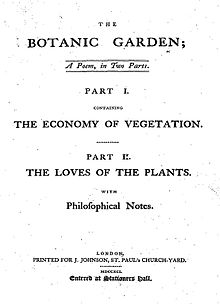
Title page from The Botanic Garden (1791)
The Botanic Garden (1791) is a set of two poems, The Economy of Vegetation and The Loves of the Plants, by the British poet and naturalist Erasmus Darwin. The Economy of Vegetation celebrates technological innovation and scientific discovery and offers theories concerning contemporary scientific questions, such as the history of the cosmos. The more popular Loves of the Plants promotes, revises and illustrates Linnaeus's classification scheme for plants.
The intent of The Botanic Garden, one of the first popular science books, is to pique readers' interest in science while educating them at the same time. By embracing Linnaeus's sexualized language, which anthropomorphizes plants, Darwin intended to make botany interesting and relevant to the readers of his time. Darwin emphasizes the connections between humanity and plants, arguing that they are all part of the same natural world and that sexual reproduction is at the heart of evolution (ideas that his grandson, Charles Darwin, would later turn into a full-fledged theory of evolution). This evolutionary theme continues in The Economy of Vegetation, which contends that scientific progress is part of evolution and urges its readers to celebrate inventors and scientific discoveries in a language usually reserved for heroes or artistic geniuses. Darwin's attempt to popularize science and to convey the wonders of scientific discovery and technological innovation through poetry helped initiate a tradition of popular science writing that continues to the present day. (Full article...) -
Yash Chopra (known as Yash Chopra: Fifty Years in Indian Cinema in India) is a biography written by the British professor and author Rachel Dwyer, chronicling the life and career of the Indian filmmaker Yash Chopra. The book details Chopra's birth in 1932 in Lahore, his career both as a director and producer, and his 1970 marriage to the then-playback singer Pamela, with whom he had two sons Aditya and Uday. The British Film Institute published Yash Chopra on 29 April 2002 in the United Kingdom and Roli Books did so on 30 July in India.
While writing All You Want is Money, All You Need is Love: Sexuality and Romance in Modern India (2000), Dwyer saw Chopra on a televised interview in 1993, which aired following the release of Darr. She watched the film and was impressed by it. She subsequently conceived a biography about the filmmaker and with some difficulty held meetings to interview him. Upon its release, the book received mixed reviews, with Dwyer's writing garnering the most appreciation, but her literal translation of Chopra's interviews from Hindi and Urdu to English generated critical negative responses. (Full article...)
Selected quote
| “ | A book is a garden you can carry in your pocket. | ” |
| — Arabian proverb | ||
Did you know
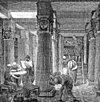
- ...that Library of Alexandria was once the largest library in the world?(Pictured)
- ...that the government of Bavaria, in agreement with the federal government of Germany, does not allow any copying or printing of Mein Kampf in Germany?
- ...that among the books that end up in the Simpson's fireplace in episode Dog of Death are The Lottery by Shirley Jackson, Fahrenheit 451 by Ray Bradbury (which ironically enough, is about a society where books are burned),and Fatherhood by Bill Cosby?
General images
-
Decorative binding with figurehead of the 12th century manuscript Liber Landavensis (from Bookbinding)
-
Modern paperback spines (from Bookbinding)
-
Page from the Blue Quran manuscript, ca. 9th or 10th century CE (from History of books)
-
European output of manuscripts 500–1500 (from History of books)
-
Hardbound book spine stitching (from Bookbinding)
-
The Codex Manesse, a German book from the Middle Ages (from History of books)
-
Rebacking saving original spine, showing one volume finished and one untouched (from Bookbinding)
-
Design by Hans Holbein the Younger for a metalwork book cover (or treasure binding) (from Book design)
-
Page spread with J. A. van de Graaf's construction of classical text area (print space) and margin proportions (from Book design)
-
Three books with different titling orientations:
(left) ascending
(middle) descending
(right) upright (from Bookbinding) -
Jikji, Selected Teachings of Buddhist Sages and Seon Masters, the earliest known book printed with movable metal type, 1377. Bibliothèque Nationale de France, Paris. (from History of books)
-
Cloth book cover with attached paper panel, mimicking half leather binding (from Bookbinding)
-
Scheme of common book design(from Bookbinding)
- Belly band
- Flap
- Endpaper
- Book cover
- Head
- Fore edge
- Tail
- Right page, recto
- Left page, verso
- Gutter
-
Early medieval bookcase containing about ten codices depicted in the Codex Amiatinus (c. 700) (from Bookbinding)
-
12-metre-high (40 ft) stack of books sculpture at the Berlin Walk of Ideas, commemorating the invention of modern book printing (from History of books)
-
An author portrait of Jean Miélot writing his compilation of the Miracles of Our Lady, one of his many popular works. (from History of books)
-
Woman holding wax tablets in the form of the codex. Wall painting from Pompeii, before 79 CE. (from History of books)
-
A traditional bookbinder at work (from Bookbinding)
-
Hardbound book with half leather binding (spine and corners) and marbled boards (from Bookbinding)
-
Marbled book board from a book published in London in 1872 (from Bookbinding)
-
Bookbinder's type holder (from Bookbinding)
-
Modern book spine designs (from Bookbinding)
-
A Sumerian clay tablet, currently housed in the Oriental Institute at the University of Chicago, inscribed with the text of the poem Inanna and Ebih by the priestess Enheduanna, the first author whose name is known
-
The Book of the Dead of Hunefer, c. 1275 BCE, ink and pigments on papyrus, in the British Museum (London) (from History of books)
-
9th-century Qur'an in Reza Abbasi Museum (from Bookbinding)
-
Example of blind tooling a book binding with exquisite detail (from Bookbinding)
-
A Chinese bamboo book (from History of books)
-
Page from a Jain manuscript depicting the birth of Mahavira, c. 1400 (from History of books)
-
Book conservators at the State Library of New South Wales, 1943 (from Bookbinding)
-
Sammelband of three alchemical treatises, bound in Strasbourg by Samuel Emmel c. 1568, showing metal clasps and leather covering of boards (from Bookbinding)
-
A 15th-century Incunable. Notice the blind-tooled cover, corner bosses, and clasps. (from History of books)
-
Dresden Codex (page 49) (from History of books)
-
The spine of the book is an important aspect in book design, especially in the cover design. When the books are stacked up or stored in a shelf, the details on the spine is the only visible surface that contains the information about the book. In a book store, it is often the details on the spine that attract the attention first. (from Book design)
-
The scene in Botticelli's Madonna of the Book (1480) reflects the presence of books in the houses of richer people in his time. (from History of books)
-
Traditionally sewn book opened flat (from Bookbinding)
-
Photograph of a printing press in Egypt, c. 1922 (from History of books)
-
Folio from the Shah Jahan Album, c. 1620, depicting the Mughal Emperor Shah Jahan (from History of books)
-
European output of books 500–1800 (from History of books)
-
Folio from a manuscript of the Shanamah (Book of Kings) (from History of books)
-
European output of printed books c. 1450–1800 (from History of books)
Books lists
WikiProjects
Categories
Things you can do

- Find news articles regarding notable books and add them to the "In the news" section.
- Expand this portal and book-related articles: List of Jamaican books
- Create new articles: Lists of books provides a comprehensive list of notable books, many of which have no articles.
- Add references: List of CEO books, List of anonymously published works
- Make this portal more complete:
- Add {{WPBooks}} to the Talk pages of articles about notable books – but try to add an initial Assessment from the Wikipedia:WikiProject_Books
- Add
{{Portal|Books}}to appropriate articles within the subject
- Anything else you can think of doing.
Web resources
- Bookbinding and the Conservation of books, A Dictionary of Descriptive Terminology, 1982 by Matt T. Roberts and Don Etherington
- IOBA glossary of book terms
- Project Gutenberg - Free e-Books
- Words at Large: The best in books from CBC.ca
- please add more!
Associated Wikimedia
The following Wikimedia Foundation sister projects provide more on this subject:
-
Commons
Free media repository -
Wikibooks
Free textbooks and manuals -
Wikidata
Free knowledge base -
Wikinews
Free-content news -
Wikiquote
Collection of quotations -
Wikisource
Free-content library -
Wikispecies
Directory of species -
Wikiversity
Free learning tools -
Wikivoyage
Free travel guide -
Wiktionary
Dictionary and thesaurus










